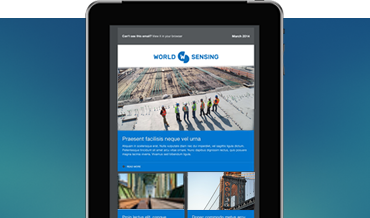We told you to ask anything. Here are your questions and our answers
Wireless monitoring is such a big topic that it can help to get experts to help you out. That’s why we invited you to ask anything you wanted to our specialists Juan Pérez Arcas and Bernat Trias during an informal webinar at the beginning of September 2020. If you missed it, don’t worry. Here’s a rundown of the main topics that were discussed. Let us know if you have further queries.
1. On your monitoring software, is it possible to have multiple sensors?
Bernat Trias: This monitoring software has several purposes. The first is to help set up the system. The second is to monitor the system is working properly, and the third is to collect all the data and expose it to visualization and analytics software. The software is designed to connect multiple Worldsensing sensors, or data loggers that may have a multitude of sensors behind them. In the future we will connect to even more sensors.
2. What is the largest panel that can be connected to the gateway and node?
Bernat Trias: Regarding the use of solar panels, the gateway is meant to have an external power, mainly from the grid or solar panels. If you use solar panels there is no limit on the size of the panel, but you should select it depending on the area you are located in and the hours of sun that you have.
3. Do you have a satellite solution?
Bernat Trias: Our gateways establish connectivity through cellular networks such as 2G, 3G and 4G, with a SIM card, or Ethernet. The customer can connect this to any other connectivity technology, including satellites. We have customers that connect their gateway through an Ethernet port to a satellite solution, and it works well.
4. How much time does it take you to integrate a new IoT provider?
Juan Pérez: I think that probably the question is about the integration of a new digital sensor into the wireless system. In this case, it is possible to integrate new digital Modbus RTU sensors in less than two or three weeks because our nodes, data warehouse and mobile app are ready for simple and easy integration of sensors using this protocol.
On the other hand, regarding other sensor interfaces like the vibrating wire or analog signals (4-20 mA, voltage, ratiometric…), the integration of a new sensor into the Worldsensing system is transparent as our nodes are compatible with these common signals. It is possible to configure formulas on our software to convert the raw measurements to converted parameters in the desired measuring unit.
5. Do you have any plans to develop nodes for use with geotechnical sensors on narrowband IoT or LTE-CAT M1 communications?
Bernat Trias: We’re following these low-power, wide-area technologies very closely, but for the moment we don’t have plans to develop nodes using them. We’ve seen that LoRaWAN is the best suited technology for our sensors, due to the low power and long-range benefits. We will continue following these technologies and if we feel that they can provide something additional to our products, we’ll be happy to include them.
6. Is it possible to get data for pore pressure while out in the field, using a smartphone?
Juan Pérez: One of the advantages of Worldsensing is that we provide a mobile app for the configuration of our nodes. With this tool, it is feasible to collect readings in the field and also locally. It is only feasible to collect raw data readings on demand at site. It is in our roadmap to be able to push the raw data from the mobile app to our cloud software to convert into pressure units in this example and to visualize it on the mobile app.
So, if you are monitoring or collecting data from a vibrating wire piezometer and you are interested in the pore-water pressure, it is possible to see the reading in the mobile app in digits or Hertz. In the short term, we also want to offer the capability of visualizing this data in engineering units. Currently the engineering units are available on the Worldsensing software but not in the mobile app.
7. Which industry sectors could benefit more from remote monitoring, especially now with a pandemic?
Bernat Trias: We are very active in construction, mining and infrastructure monitoring. I would say the sectors that can benefit more are the sectors that are not automated yet or that have to deploy many people in the field. With remote monitoring, we can avoid or reduce the number of people in the field, so we get benefits in terms of costs but also in terms of security. In some industries, being in the field can bring risks.
In terms of the pandemic, we’re limiting movement a lot so any system that helps any sector automate data gathering instead of sending people into the field could benefit from that.
8. Will an LTE-equipped internal modem be coming to the gateway?
Juan Pérez: In the coming weeks, we will start shipping 4G gateways to North America. In addition to the advantage of integrating an internal LTE modem, to deal with the discontinuation of 3G in North America it also comes with a wider operating temperature.
9. Is the -20ºC minimum temperature on the gateway truly the limit?
Juan Pérez: It will be possible to operate down to -20ºC without any issues. We have experience in some mines in Canada and Sweden where the gateways are operating below -20ºC and close to -40ºC. In general, all the electronics we are using operate from -40ºC to 80ºC. The gateways have some differences but it is always possible to find a proper solution in these cases.
10. How do you integrate this, if at all, into old miles of track that the owners do not want to touch in any way?
Bernat Trias: Worldsensing can be installed in existing infrastructures, with existing sensors. One of the advantages of our technology, depending on the conditions, is it can cover several kilometers. In very long projects, across thousands of miles, we have to install several gateways and space them several kilometers from gateway to gateway. By doing this, we could cover a very big area.
In the end, we have the software to control all of these installations, with many gateways and thousands of nodes, all in a central place.
11. How do you share, anonymize and monetize the data being produced?
Bernat Trias: We’re using LoRa technology and data encryption end to end so that data is encrypted from the sensor to the software. The customer is the owner of this data. They have access to the software, and they do what they want with this data. They can export it to other programs through APIs, but we don’t resell or re-use this data with other people. It’s the customers that decide what they want to do with this data.
12. How can you link this to drones and other data-sensing devices?
Bernat Trias: We have a wide range of devices compatible with our system, but it can be extended. We’re working to integrate more LoRa devices into our system. We will also integrate devices from other technologies, like 4G. In future, we will be able to integrate drones and other sensing devices but for the moment we are focused on the digital sensors that can be easily integrated.
13. Is this built on LPWAN, 4G or another technology?
Bernat Trias: It’s using low-power, wide-area technology to connect the sensors with the gateway LoRa in this case. But the gateways can be connected toInternet or your local servers, through ethernet or an internal modem that can be 3G or 4G.
14. What is your experience regarding the monitoring of bridges and what technology do you use to do that ?
Juan Pérez: One important application of our wireless tiltmeter is to monitor the angle variation in bridges piers. Worldsensing is ready to monitor parameters that are evolving slowly in time. For bridge monitoring, typical applications of our system are to monitor displacement in the joints of a bridge and the angle variation in some locations, and also force and strain measurements. In addition, it is also possible to monitor the load placing load cells on the cable stays or the prestressing tendons.
Also, there are some applications where our nodes are monitoring the force in the pot bearings, via pressure sensors. Furthermore, there are applications for the laser distance node related to the monitoring of relative displacements in bridges.
15. What is the life of a battery?
Juan Pérez: The expected battery life depends on the sensor and frequency of data acquisition and transmission. For example, the battery life of one node reading five vibrating wire sensors hourly is seven years, while the battery life of a wireless tiltmeter reading every five minutes is 1.2 years.
16. Would you also manage battery replacement of devices?
Juan Pérez: The batteries can be provided locally. We recommend Saft LSH 14 models. There are other alternatives in the market. Is it possible to open the nodes on site for battery replacement. In our software, we have implemented alerts that are sent by email when a node is disconnected and also low battery messages in some of our nodes. We will implement additional capabilities to improve the battery management in the near future.
17. In mines two to three kilometers underground, which devices would you recommend, knowing signal and data collection is going to be a challenge?
Juan Pérez: Underground mining is a challenging environment for radio networks. More than depth, the important point is how the obstacles affect the radio transmission. It is not possible to achieve the same coverage as outdoors. However, thanks to the introduction of communication technologies for automated mining it is easier to provide connectivity to LoRa gateways. Regarding the recommended devices, any device from our portfolio is suitable to operate in these conditions.
Depending on your monitoring need we can suggest what device fits your project.
18. From a latency point of view, how do you think your architecture will help us resolve data challenges?
Juan Pérez: Worldsensing is for near real-time monitoring. The highest sampling rate available is 30 seconds. Worldsensing is typically used to monitor slow varying parameters over a long period and in this case a latency in the order of minutes is really good. You have to consider that frequently these parameters are manually read using handheld units. For applications requiring real time, our innovation team is exploring dynamic acquisition and triggered transmission modes of operation. It is one of our lines of research.
19. Is it possible to connect your sensors, for example, to the Azure IoT hub service?
Answered by Albert Zaragoza: Worldsensing is able to expose the data from data loggers and sensors following two standards, REST APIs and MQTT protocols. Both of these are accepted as valid messaging protocols by the Microsoft Azure platform so there should be no problem for the data to be ingested to the Azure IoT hub Service.
20. Are they certified for use on this platform?
Albert Zaragoza: No, they are not certified, although there is no reason why the data cannot be ingested and treated via the Azure Cloud services.

